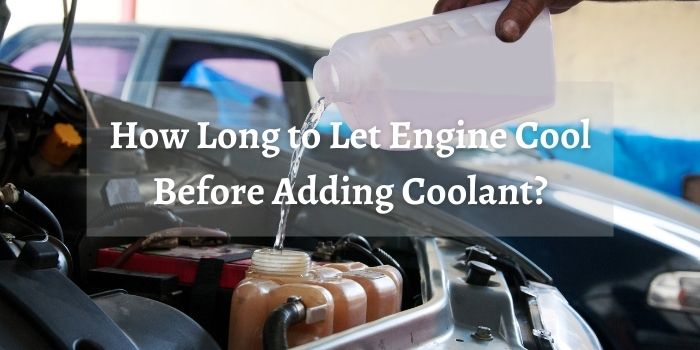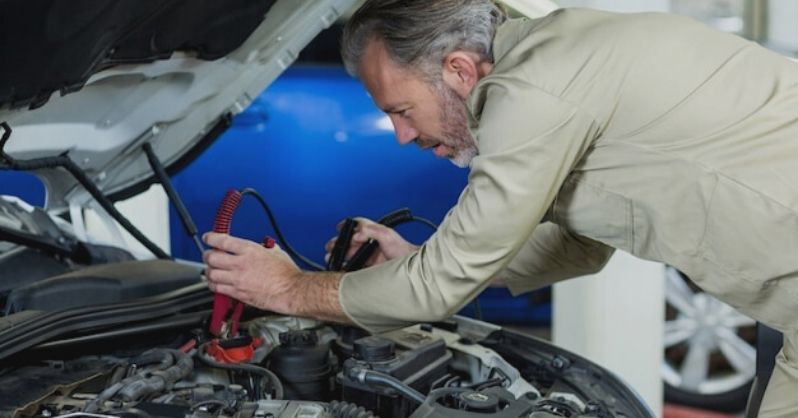Do you know how long to let engine cool before adding coolant? If not, don’t worry, you’re not alone!
However, there are actually some benefits to adding coolant before the engine gets too hot.
So, in this blog post, we’ll discuss how long to let your engine cool down before adding coolant by providing some factors that can affect the cooling time. Stay tuned!

How Long to Let Engine Cool Before Adding Coolant?
When the engine is turned off, the coolant continues to circulate and cool the engine until it reaches room temperature. For this reason, it is important to let the engine cool completely before adding more coolant.
So, how long should you wait before adding more coolant? It depends on the temperature outside and how long the engine has been turned off, but generally it needs an hour or two to cool completely.
Does My Engine Need to be Cold to Add Coolant?
We know that low coolant can cause check engine light. However, many don’t know that the engine in your car needs to be at a certain temperature for the coolant to work properly. If the engine is too cold, the coolant can solidify and clog up the system. This can be the reason behind the reduced engine power in Chevy Impala.
Conversely, if the engine is too hot, the coolant can boil and turn into steam, causing damage to the engine.
For this reason, it is best to check the level of coolant when the engine is at operating temperature, which is typically around 90°C.
Will It Be Safe to Add Cold Coolant to a Hot Engine?
No, it’s not safe to add cold coolant to a hot engine.
The sudden change in temperature can break the engine block. In addition, the cold liquid will join with the hot liquid, creating a mixture that is both ineffective and dangerous.
If your engine is overheating, it’s best to shut it down and allow it to cool before adding any new coolant.
What Are the Factors Affecting Cooling Time?
Some factors can be responsible for causing the cooling time to be lengthier or shorter. Let’s find out how!
Ambient Temperature
In summer, the high temperatures can cause the engine to overheat more quickly, and it may take 30 or 40 minutes to cool down to the room or ambient temperature.
In winter, the cooler air can help to prevent the engine from overheating, and it may only take 20 to 30 minutes for the engine to reach a safe temperature.
The cooling time of your car engine is also affected by the amount of traffic on the road. If there is a lot of traffic, the engine will take longer to cool down. If there is less traffic, the engine will cool down faster.
Heat Insulation System
Cars generate a lot of heat, and if that heat is not properly contained, it can lead to engine damage. That’s why most cars have some form of heat insulation system.
The most common type of heat insulation system is the ceramic thermal shield. This system uses Kevlar or other high-strength fibers to create a barrier between the engine and the car’s interior.
The foam reinforced heat shield is another popular type of system. This system uses a layer of foam to deflect heat away from the engine.
Amount of Remaining Coolant
If the tank is completely empty, it will take much longer for your engine to cool down than if there is some coolant remaining.
Consequently, it is important to check the level of coolant in your radiator tank regularly and top it off as needed. However, if you do need to add coolant, it is best to wait 30-40 minutes before doing so.
This will give the engine a chance to cool down slightly and allow the new coolant to circulate properly.
How Much the Engine Is Heated
If the engine is too hot, it can take longer to cool down. The weather condition can affect how quickly the engine cools down.
If it is a cold day, the engine will cool down more slowly than on a warm day.
The type of road you are driving on can also affect how quickly the engine cools down. If you are driving on a rough road, the engine will vibrate more and will take longer to cool down.
The quality of the coolant can also affect how quickly the engine cools down. If the coolant is old or of poor quality, it will not be as effective at cooling the engine.
Also, oil with a high viscosity will take longer to circulate and will therefore take longer to cool down the engine.
Finally, the size of the engine also plays a role in cooling time. A larger engine will take longer to cool down than a smaller engine.
Materials of Engine Head
If an engine head is made from a lightweight material it will heat up more quickly, while a head made from a heavier material will take longer to heat up.
In addition, the type of metal used in the head can also affect cooling time. A head made from aluminum will dissipate heat more quickly than a head made from cast iron.
Why Should You Wait Before Adding Coolant to a Hot Engine?
Adding cold coolant to a hot engine can cause thermal shock, which can damage the engine causing various issues. Let’s take a look at them below-
Engine Block Can Crack
When your car’s engine is hot, adding cold coolant can cause the engine block to crack.
That’s because the metal of the engine block expands when it’s hot. When you add cold coolant, the sudden change in temperature can cause the metal to contract too quickly.
It will create stress points that can eventually lead to cracks.
Coolant May Overflow
If you add coolant to a hot engine, it can cause the coolant to overflow from the radiator once the engine has cooled.
This is because ethylene glycol, the main ingredient in coolant, expands in vapor form when heated. As a result, adding coolant to a hot engine can cause the reservoir to overflow, leading to expensive repairs.
Hot Vapor Is Harmful
When your engine is hot, the coolant is under pressure. If you remove the radiator cap without letting the engine cool first, the hot coolant will erupt out of the opening.
The escaping steam and hot coolant could seriously burn you.
Blow Up the Engine
If you don’t wait before adding coolant to a hot engine, you can cause the engine to “blow up.”
The coolant will mix with the hot oil and create a sludge that will clog the engine and cause it to overheat. This can lead to severe damage or even destruction of the engine.
Leakages in Radiator Pipes
If you don’t wait for your radiator to cool down before adding coolant, you risk causing leaks in the radiator pipes.
The coolant is under pressure when it’s hot, so adding more while the engine is still hot can cause the coolant to force its way out through any weak spots in the pipes.
How Can I Cool Down My Engine Fast?

First, turn off the AC. This will help to reduce the amount of heat that is being generated by the engine.
Another is to turn on the heater. This will help to dissipate the heat from the engine.
You can also put the car in neutral and pull over to the side of the road. This will allow the engine to cool down more quickly.
Finally, you can open the hood of the car and let some of the heat escape.
What to Do While the Engine is Cooling Down?
The best way to cool down your engine is to drive at a moderate speed for the last few minutes of your journey, then turn on the ignition and let the engine idle for a minute or two.
This will give the engine time to adjust to the new temperature gradually and will help to prevent any long-term damage.
You should also check the coolant level and quality before adding coolant.
FAQs
1. Is it okay to drive right after adding coolant?
It’s generally fine to drive after adding coolant, but there are a few things to keep in mind. First, be sure to check the coolant level often and top it off as needed. Second, use only coolant that meets the requirements of your vehicle’s manufacturer. And third, keep an eye on your engine temperature gauge and watch for any overheating.
2. How long after adding coolant will I be able to drive?
It is important to wait at least 15 minutes after adding coolant to your car before driving. This will give the coolant time to circulate and ensure that it is doing its job properly.
If you drive too soon, the coolant may not have had enough time to reach all of the engine parts, potentially leading to overheating. In addition, if there are any leaks in the system, driving too soon could cause the coolant to leak out before it has a chance to take effect.
3. How long should I allow the car to run after adding coolant to ensure prevention of overheating?
The coolant needs time to circulate through the engine and lower the temperature. As a general rule, you should let the car run for at least 10 minutes after adding coolant. This will give the fluid time to do its job and help ensure that your car does not overheat again in the future.
4. What’s better between coolant and water for car engines?
Water is the cheaper option and it’s easy to find, but it doesn’t last as long as coolant and it can cause corrosion. Coolant, on the other hand, is more expensive but it lasts longer and helps to protect against corrosion. However, a blend of water and the coolant is better.
5. Is it okay to overfill the coolant?
No, it’s not. First, it can lead to engine damage as the coolant level rises above the reservoir and into the engine itself.
Second, it can cause the coolant to become too dense, making it less effective at cooling the engine. Finally, overfilling the coolant can cause leaks, as the pressure buildup from the extra fluid can force its way out of weak spots in the system.
6. Are coolants toxic?
In general, coolants are not considered to be toxic. However, some coolants may contain chemicals that can be harmful if they are inhaled or ingested. That’s why Coolants should always be used in well-ventilated areas, and proper safety precautions should be taken when handling them.
Conclusion
So now you know – if your car has been running hot, let it cool down for at least an hour or more before topping off the radiator with antifreeze. Otherwise, you may find yourself stranded on the side of the road in the middle of winter (or summer).